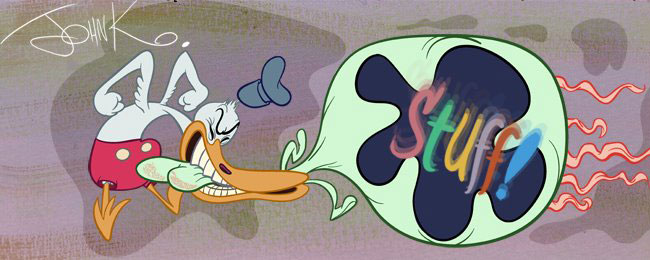 This drawing of Tom, at first glance looks very complicated. There are a lot of lines and details and hairs that could possibly distract you from the contruction and logic of the face. Jerry and Tuffy's faces are simple by comparisn - BUT THEY FOLLOW THE SAME LOGIC.
This drawing of Tom, at first glance looks very complicated. There are a lot of lines and details and hairs that could possibly distract you from the contruction and logic of the face. Jerry and Tuffy's faces are simple by comparisn - BUT THEY FOLLOW THE SAME LOGIC.Tom is just more detailed than the mice, because his drawing is so much bigger. The bigger your character is on screen, the more detail and contrasts in sizes you can take advantage of - if you know what you are doing.
Tom becomes simpler once you understand the basics of construction and facial mechanics .


FACIAL MECHANICS BASIC:
 Facial mechanics are the logical ways that faces make expressions. How when one part of the face moves, it pulls or pushes other parts. It starts with knowing what the basic features are that make an expression.
Facial mechanics are the logical ways that faces make expressions. How when one part of the face moves, it pulls or pushes other parts. It starts with knowing what the basic features are that make an expression.Eyes
Eyebrows
Mouth Shape
Cheeks
Those 4 basic parts can add up to an infinite amount of expressions. They each can be broken down into sub parts:
Eyes have pupils.
Eyebrows have accompanying brow wrinkles and sometime individual hairs.
The mouth has an upper lip, a lower lip, a hole when its open, teeth and a tongue.
All these sub forms can help define or refine the basic expression made by the basic parts.
For example:

 The wrinkles on the brow that accompany the eyebrows themselves are part of the brow muscle that is making the expression. The wrinkles go where the hairy parts go. Follow the fur, I always say. They follow along and obey the same planes and forms. The space between the wrinkle and the eyebrow should form worm0like fleshy tubes that wrap around the construction of the head.
The wrinkles on the brow that accompany the eyebrows themselves are part of the brow muscle that is making the expression. The wrinkles go where the hairy parts go. Follow the fur, I always say. They follow along and obey the same planes and forms. The space between the wrinkle and the eyebrow should form worm0like fleshy tubes that wrap around the construction of the head.No lines on a face should ever just float around in space. Every line should have meaning and sense.
Knowing all this, you can then break down logically how this drawing of Tom's head, face and expression works, step by step.
Starting with the main features, then working down to the details.
And making sure the details obey the directions of the larger features.
WORK OUT BASIC CONSTRUCTION AND BASIC EXPRESSION FIRST

THEN WRAP THE DETAILS AROUND THE BASIC FORM AND EXPRESSION
 Mouths are more complicated than eyes and brows because they have more parts and a lot more pliability than the other features, so I'll leave the mouth for another post.
Mouths are more complicated than eyes and brows because they have more parts and a lot more pliability than the other features, so I'll leave the mouth for another post. Cartoon wrinkles follow the same basic logic and mechanics as real ones. They are secondary features that help define main features.
Cartoon wrinkles follow the same basic logic and mechanics as real ones. They are secondary features that help define main features. You can really see the hierarchy of the main facial features vs the accompanying lesser wrinkles and folds that follow them, in this bust.
You can really see the hierarchy of the main facial features vs the accompanying lesser wrinkles and folds that follow them, in this bust. Human faces are more complex than cartoon faces and harder to draw. Everything becomes easier when you understand the logic and hierarchy of it all.
Human faces are more complex than cartoon faces and harder to draw. Everything becomes easier when you understand the logic and hierarchy of it all.
But you gotta practice and copy good drawings using the construction method if you are to make any real gains in skill and understanding.
Just thinking about it won't make your drawings any better.

